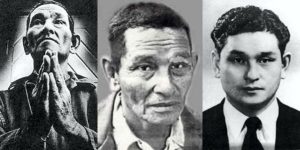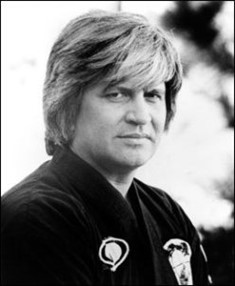The History of Kempo (Kenpo)
This section and the sections that follow in their entirety are primarily based upon information found within the International Kempo Federation website. Additional citations and reference information can be found at the end of the article.

The art of Kempo (or Kenpo) is considered by many to have its founding roots stretching back as far as 520 B.C. with a prince and warrior of southern India named Bodhidharma.
According to the records of the Lo-Yang temple, Bodhidharma was a Buddhist monk under the watchful eye of Prajnatara and it is said that upon his death bed, Prajnatara requested that Bodhidharma travel to China where he felt the principles of Buddhism were in decline. He desired that the knowledge of dhyana (Zen Koans) should be known to the people living there.
Once Bodhidharma arrived, he was saddened to realize that not only did the Emperor Wu of the Liang Dynasty demonstrate no interest, but the famed Shaolin temple and its inhabitants within the Honan Province were completely physically and mentally diminished.
It is said that the monks within the temple were in such a ragged condition that they would often simply fall asleep in meditation and participate in little else, they were so feeble in their state of life.
For an unknown period, Bodhidharma meditated in a cave at the outskirts of the temple seeking for a way to renew Buddha’s light and provide inspiration so the monks could regain control over their lives once again. Upon his return, Bodhidharma gathered the monks into the courtyard, and began to instruct them in the art of Shih Pa Lo Han Sho, or the 18 hands of Lo Han.
These techniques, which are the foundation for almost all martial arts today, were never originally intended to be utilized as methods of fighting but were a way the monks could attain enlightenment while preserving their bodies health.
Approximately forty years or so after the death of Bodhidharma it is said that many assaults began to fall upon the Shaolin monastery until the early twentieth century. One of the monks of the temple, with a reference only as the “begging monk” attacked several of the criminals with an array of aggressive hand and foot techniques, killing some and driving the remaining attackers away. The other monks were so inspired by the display of this single priest that they requested instruction in this martial arts style as a means of protection. In later scripts this fighting art was recorded as Chuan Fa or “Fist Method”.
The fighting arts of the Shaolin temple continued to grow and were said to prosper to over 400 arts in total over the next several centuries. Several decades after the fight of the begging monk, a master of Chuan Fa named Ch’ueh Taun Shang-Jen was said to have rediscovered the original Shih Pa Lo Han Sho which had been lost for many years.
Ch’ueh integrated his art of Chuan Fa increasing the total number of techniques from the original eighteen to a total of seventy-two. For several years after this period, Ch’ueh traveled the countryside of China promoting his art in several grueling fighting matches until he came upon a man named Li in the province of Shensi.
Li, a master of Chuan Fa as well as other martial arts traveled and trained with Ch’ueh for some time developing the curriculum of Chuan Fa to form a total of one-hundred and seventy techniques. They categorized these techniques into five distinctive groups distinguished by various animals whose instinctive reactions best reflected the movements of this new Chuan Fa. Upon their return to the Shaolin temple of which both Li and Ch’ueh belonged they presented to the other monks Wu Xing Quan, the five animal forms and brought to the Shaolin temple a new stage in martial arts evolution.
Over the next several centuries, the history of Chuan Fa and its steps towards Kempo is broken in its tales. What is known is that the art of Chuan Fa remained and is still practiced in China, but it’s teaching also found its way to Okinawan Islands and the Ryukyu kingdoms as well as Japan. In both places, the art was referred to as Kempo or Law of the Fist.
Between the Sui and Ming periods (an 800-year gap) it is considered that many a wandering monk traveled across Japan and Okinawa bringing with them a working knowledge of the art of Kempo which explains its wide-spread distribution. The art of Chuan Fa which translates into Kempo would have been taught as a supplement to the daily spiritual training the monks endured. Many of the monks would often choose disciples or teach at various Buddhist temples bringing forth the word of Buddha, and the power of Chuan Fa. From there the art of Kempo could have easily spread among the commoners and nobles.
Kempo (Kenpo) in the United States

The first evidence we have of Kempo in America begins in the early 1900’s in Hawaii. In 1916 at the age of five, James Mitose was sent to Kyushu, Japan from his homeland in Hawaii for schooling in his ancestor’s area of self-defense called Kosho Ryu Kempo (a direct descendent of the original Chuan Fa). He studied in Japan for fifteen years, and after completing his training, Mitose returned to Hawaii and in 1936 opened the “Official Self-Defense” club in Beretania Mission in Honolulu.
 While Mitose may have been the first on record to bring Kempo to the United States, William K.S. Chow is perhaps responsible for the largest leap of Kempo to the general public.
While Mitose may have been the first on record to bring Kempo to the United States, William K.S. Chow is perhaps responsible for the largest leap of Kempo to the general public.
Chow studied Kempo under Mitose for several years. In 1949, Chow had attracted several students to his own teachings and opened a dojo of his own at a local YMCA. To make a distinct variation from Mitose’s Kempo, Chow referred to his art as Kenpo Karate.
Because Chow had previously studied his family’s art of Kung Fu as well, he decided to blend his knowledge of styles together and created Kara-Ho Kempo. This Kempo offshoot is a blend of the Kosho Ryu Kempo and 5-animal Kung Fu of the Chow Family.
Kara-Ho Kempo utilizes many circular as well as linear techniques and requires 500 such techniques to be learnt for black-belt status. Currently, Kara-Ho Kenpo is under the evolution of Sam Kuoha who has added various new techniques as well as 12 kata based on Chow’s original 12 base linear techniques.

One of Chows most well-known students was a Hawaiian native named Edmund Parker. Ed Parker, as he was best known, is a highly significant figure in the current tale of modern Kempo. In 1954, Parker earned his black belt in Kara-Ho Kenpo and two years later became well-known for teaching his art to the likes of Elvis Presley and Steve McQueen.
Ed Parker further refined and defined the techniques of Kara-Ho Kenpo until he launched his American Kempo Karate system on the west coast of the continental United States.
 Another pioneer of American Kempo began opening studios on the east coast in the mid 1960’s. Nick Cerio also trained under Professor Chow and received his 5th degree black belt (Master) from him in 1971.
Another pioneer of American Kempo began opening studios on the east coast in the mid 1960’s. Nick Cerio also trained under Professor Chow and received his 5th degree black belt (Master) from him in 1971.
Seeing Professor Cerio’s skill and potential, Professor Chow told him that he should develop his own system of Kempo for mainland America. A unique aspect of Cerio’s Kempo is his diverse comprehension of multiple martial arts systems. He received:
- 1st degree black belt in Karazenpo Go Shinjutsu
- 1st degree black belt in Hakkoryu Jujutsu
- 3rd degree in Parker’s Kempo Karate
- 5th degree black belt in Okinawan weapons and self-defense under Tadashi Yamashita
- 8th degree black belt in Sil Lum kung fu
Grandmaster Cerio was also awarded the title of Professor in 1989 by Thomas Burdine.
Cerio credits both Chow and Parker with the creation of his style. The Cerio Kempo School believes in the “old method of training”, and teaches most of the Shotokan forms, Kung Fu and Kajukenbo forms, TKD kicks, Japanese stances, as well as Jujutsu. Weapons of both Chinese and Japanese systems are taught and maintains many traditional forms. Cerio calls Chow his “teacher” and Parker his “coach”. He founded a branch of Kempo known as ‘Nick Cerio’s Kempo’ which he built up to an organization of schools in the United States, Canada, Europe and South Africa.
Throughout its history, Kempo has been practiced in diverse ways, reflecting the beliefs and needs of each era. It has absorbed concepts from Zen Buddhism and other philosophical systems, giving rise to a martial art that not only emphasizes physical prowess but also mental discipline and self-improvement.
In the modern era, Kempo has diversified into various styles and schools, each with its unique approach and techniques. From traditional to contemporary interpretations, Kempo continues to evolve, embracing innovations while staying rooted in its historical foundations.
The history of Kempo is a testament to its resilience, adaptability, and enduring appeal. It has evolved from its origins in ancient China to become a global martial art that embodies both physical techniques and profound philosophical principles. As practitioners continue to explore its rich history and refine its techniques, Kempo remains a dynamic, evolving, and enduring force in the world of martial arts.
References
International Kempo Federation. (2023). Kempo History. Retrieved from http://www.kempoikf.com/en/page/kempo-history-10
Logans Martial Arts Academy. (2023). Kenpo History. Retrieved from http://www.logansmartialarts.com/history.php
Wikipedia. (2023). Nick Cerio. Retrieved from https://en.wikipedia.org/wiki/Nicholas_Raymond_Cerio
James Mitose photo courtesy of USADojo.com
William Chow photo courtesy of Kenpo.net
Ed Parker photo courtesy of CombatFusion.com
Nick Cerio photo courtesy of ZUltimate.com






